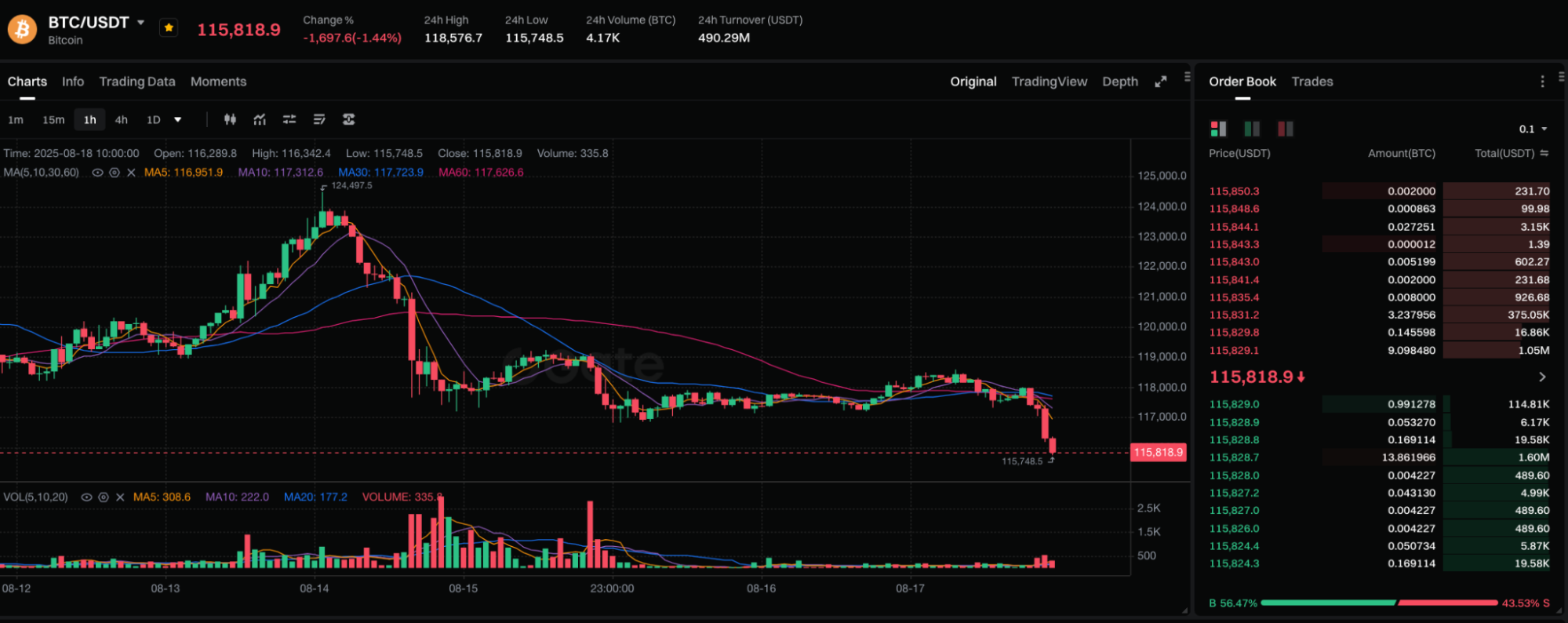Crypto Market Cap Surpasses $4 Trillion, BTC Dominance Faces New Challenges
Bitcoin Reaches New All-Time High, Total Market Cap Tops $4T

Source: https://www.gate.com/trade/BTC_USDT
Recently, Bitcoin’s price has climbed steadily, setting a new all-time high of $124,000. This surge has not only boosted BTC’s market capitalization but also pushed the total crypto market capitalization past $4T. Investor enthusiasm for Bitcoin continues to intensify, particularly as institutional capital flows in and drives a notable increase in overall market confidence.
The rapid expansion of the crypto market underscores growing investor recognition of digital assets. With more participants joining, both trading volumes and liquidity have increased, further enhancing the market ecosystem. Bitcoin’s elevated price has also bolstered market sentiment, prompting many investors to explore the potential of altcoins.
BTC Dominance Falls Below 60% for the First Time
While Bitcoin hit record highs, its market dominance dipped below 60% for the first time, now standing at around 57%. This shift signals that Bitcoin’s influence over the broader market has diminished relative to the past. The drop in dominance highlights the rise of altcoins and other digital assets, as investors diversify capital into a wider array of promising projects.
The decline in dominance also points to a more diversified market structure, with the sector is no longer reliant solely on BTC. For investors, this diversification brings new opportunities, but it also increases overall volatility. Building a balanced portfolio can help manage risk while capturing growth opportunities across various digital asset classes.
Altcoins Stand Out with Strong Performance
As BTC dominance recedes, altcoins such as Ethereum (ETH), Binance Coin (BNB), and Solana are delivering standout results. Ethereum has broken through $4,600, with its market cap nearing $520 billion as the smart contract and decentralized application (dApp) ecosystem continues to grow.
Innovative projects and ongoing technology upgrades are fueling altcoin gains. For example, Ethereum’s upgrades have improved transaction speed and reduced fees, while high-performance, low-cost chains like Solana have attracted a large developer and user base. These factors are steadily increasing altcoins’ share of the market. This trend further reduces BTC’s relative dominance.
Favorable Policies and Institutional Capital Inflows
Globally, supportive regulatory policies have played an essential role in the crypto market’s recent progress. Stablecoin regulations, Bitcoin ETFs, and the launch of compliant exchanges have opened more gateways for institutional investors. The influx of institutional capital has driven gains across both BTC and altcoins, fostering greater market maturity and stability.
Favorable regulatory developments are not only boosting investor confidence but also accelerating standardization across the sector. As increasing amounts of regulated capital enter the market, acceptance of crypto assets is rising, and the outlook for longer-term expansion is promising.
Market Outlook
Despite a dip in BTC dominance, Bitcoin remains a core asset within the digital asset landscape. Whether it can regain greater dominance will depend on future market developments, technological breakthroughs, and shifts in regulatory policy.
Investors should keep an eye on several critical factors: whether BTC can hold its high prices and continue drawing in fresh capital; whether the altcoin ecosystem sustains innovation and growth; and whether global regulatory frameworks further support digital asset development. Overall, the crypto market is set to evolve with increasing diversification, as both BTC and altcoins continue to push the industry to new heights.
Conclusion
The crypto market surpassing a $4T total market cap underscores the growing significance of digital assets in the world financial system. While BTC has achieved new price highs, its dominance has slipped to 57%, allowing altcoins greater potential for growth. Ongoing technological innovation, favorable policies, and persistent institutional investment all indicate robust potential for the sector. Investors should monitor market trends and allocate assets strategically to remain competitive in this rapidly evolving environment.
Related Articles

Pi Coin Transaction Guide: How to Transfer to Gate.io

What is N2: An AI-Driven Layer 2 Solution

Grok AI, GrokCoin & Grok: the Hype and Reality

How to Sell Pi Coin: A Beginner's Guide

Crypto Trends in 2025
